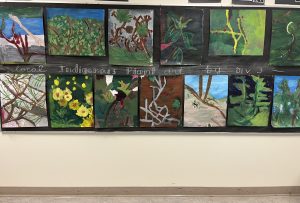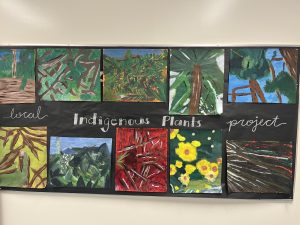I. General Information
School Name: Trout Creek Elementary
School District: SD#67 Okanagan Skaha
Inquiry Team Members: Ashley Aoki: aaoki@sd67.bc.ca, Dustin Hyde: dhyde@sd67.bc.ca, Al Beckingham: abeckingham@sd67.bc.ca
Inquiry Team Contact Email: aaoki@sd67.bc.ca
II. Inquiry Project Information
Type of Inquiry: NOIIE Case Study
Grade Levels Addressed Through Inquiry: Primary (K-3), Intermediate (4-7)
Curricular Areas Addressed: Arts Education, Language Arts – Oral Language, Science
Focus Addressed: Indigenous understandings (for example, Traditional Knowledge, oral history, reconciliation), First Peoples Principles of Learning, Indigenous pedagogy, Inquiry-based learning
In one sentence, what was your focus for the year? Supporting Elementary Educators to continue instructing from an Indigenous pedagogical frame in thoughtful, respectful, responsible ways.
III. Spirals of Inquiry Details
Scanning: Our team used the Network of Inquiry and Indigenous Education “School Tours” framework. In order to complete the scan, we had a small group of educators (11) attend an after-school learning session to lay the foundation for a successful “learning rounds” experience and collect information about what our groups strengths were and what they wanted to see to address their professional stretch points. The scanning process was completed by asking the educators the questions from the framework through an online platform, NearPod. This gave us, as facilitators, an opportunity to see where our groups reported areas of strengths were, have a clearer idea of where their stretch points might be, and discover what they wanted to observe during the learning rounds.
Focus: At the beginning of each year, data is collected from educators in the district about what they are looking for in the area of professional development. Based on the data, Indigenous Education was identified as a high priority for educators. While several professional development sessions were offered during our PD Days, we felt that providing educators the “learning rounds” opportunity to engage, observe, and reflect as a group would continue to build capacity for those who participated – and their colleagues at their school sites.
Hunch: Our concern was that educators were still hesitant to instruct from an Indigenous Pedagogical Lens.
As we looked through the data, we did notice that there continued to be feelings of hesitancy when instructing through an Indigenous Pedagogical Lens. Some of the educators had several years of experience in the field, and some were in their first contract. Some were looking for a place to begin when integrating Indigenous Ways of Knowing and Being into their instructional practice, and some folks were looking for ways to continue enriching their instructional practices with other creative ideas. Folks did share that they did feel personally connected to the territory in which we lived on, which gave us (as facilitators) an excellent shared beginning point.
New Professional Learning: We chose to create “Learning Rounds: Indigenous Pedagogy”. We used the “School Tours” framework from the Network to support our learning rounds. Our design was created so that educators were asked to engage in an after-school learning session, observe (release morning) in one of the facilitators (Ashley Aoki) classrooms, and connect and reflect (release morning) as a group at one of our learning sites in the district.
Taking Action: Based on the data/feedback we were provided, we chose to structure our observation session so that educators could see:
– How the First Peoples Principles of Learning can be woven intentionally into daily instruction.
– How talking circles can be led using the local Syilx Peoples’ protocols
– How to use the inquiry process to create projects that are cross-curricular and designed for ALL learners’ success
Checking: During our final session we gathered as a group and shared feedback about what differences were made for our group (individually and as a collective).
Seeing the First Peoples Principles of Learning as individual magnetized statements on the whiteboard was noted as a simple way to make them more accessible. Educators could see how they can be moved to different parts of the whiteboard when they naturally or intentionally (or both) emerge in the learning. For example, in Math, one common statement is “Learning takes patience and time”, which could be centered on the whiteboard and referenced to.
We completed movement breaks taken from the document “Linking Indigenous Cultural Sports and Activities to Physical Literacy” and educators mentioned they were able to apply this practice in their classroom the next day.
A number of the educators were curious about how they could also design a project for their students that accurately reflects their name and cultural identity after hearing students in the observation classroom reflect on their name and cultural identity project, and how it connected to learning about the impacts of settlement in this country.
One educator noted that the classroom environment visually reflected Indigenous Ways of Knowing and Being and wondered how they could shift their learning space, too, to reflect the natural world.
Educators were inspired by the students as they listened to the way students were learning about the traditional ecological knowledge that exists in this territory, and watched as the students carefully designed an art project to reflect one of the plants they photographed on the land.

 Photo description: Trout Creek Elementary, local Indigenous Plant Art (final project), photo taken by Ashley Aoki (click image to enlarge)
Photo description: Trout Creek Elementary, local Indigenous Plant Art (final project), photo taken by Ashley Aoki (click image to enlarge)
Students in the observation class also shared about a recent experience that they had where they interviewed an Indigenous (Cree) author after listening to his chapter book. The experience invited the educators to consider ways they could use texts authored by BIPOC peoples to continue amplifying their voices in their contexts.
Reflections/Advice: This particular process certainly was noted as one that supported the educators who participated in the learning rounds. One educator mentioned that the “learning rounds” framework is one to be continued in the following years. Our professional development sessions took place during the spring, and we are reflecting on how impactful it could be to complete “learning rounds” again in the fall as well as the spring. This is something worth considering for the future.
